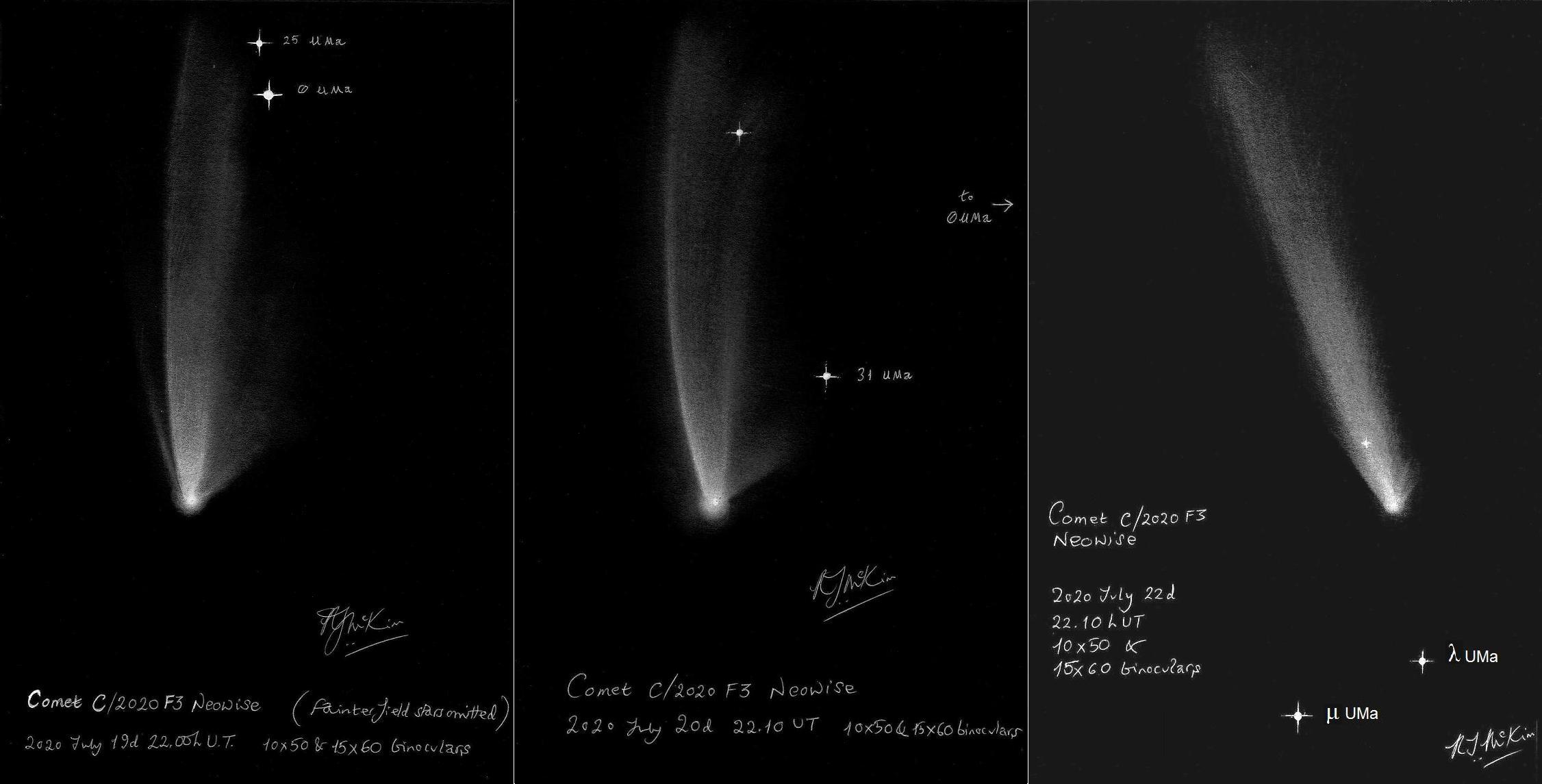My north horizon is not good, but eventually I had some decent views with 10 x 50 and 15 x 60 binoculars, and naked eye. I could not get my large telescope onto it. By the time I got to see it, the comet was less spectacular than Hale-Bopp in 1997, but still it was a decent object. There are three reasonable drawings which I have attached, and my notes are as follows, though I do not possess precise magnitudes of the comparison stars:
July 19d 2200UT Sky transparency very good
10 x 50s - Tail directly visible to at least 5 degrees, but by averted vision seems to extend at least to 7 degrees. Colour of dust tail and head is slightly yellowish. Nucleus DC 5. Coma diameter 8 arcmin. Magnitude (out of focus) = theta U Majoris (approx. 3.0).
15 x 60s - Yellowish tint of coma and dust tail slightly more apparent. The ion tail is much better seen, but I cannot see colour in this tail. I believe there is a slight twisting of the brighter part of the tail as it leaves the inner coma. DC 5.
naked eye - Tail by averted vision also to at least 5 degrees. By 2210UT it was definitely a little longer, but a trace of haze came up to end the session.
July 20d 2210UT Sky transparency excellent
10 x 50s - Much as last time but despite the better sky and the use of a tripod clamp the comet as a whole is a little fainter and the ion tail oddly is not seen for sure. Magnitude (out of focus) = theta UMa + 0.5 (approx. 3.5). Coma diameter 8 arcmin. The DC is higher than last night, DC 6. Tail (dust) directly visible to about 5 degrees long.
15 x 60s - The nucleus is definitely more condensed tonight, and particularly so with the larger aperture, DC 8, and nearly starlike. (Confirmed by Michelle McKim, who observed with me both nights).
naked eye - Same impression as 19th.
July 22d 2215UT Sky transparency excellent
10 x 50s - Tail seen to about 5 degrees again by a.v. but only 4 degrees directly. Coma diameter 8 arcmin. DC 6. Magnitude (out of focus) = lambda UMa +0.3 (approx. 3.3). The coma and dust tail colour is recorded as being off-white.
15 x 60s - Again the best view. The nucleus is not quite as condensed as on the 20th and my estimate is DC 7. The dust tail remains broad with both binoculars. Tonight there is again a faint sign of the ion tail, and I believe two very short and faint tails are seen in the 1-2 o'clock region in the field oriented with respect to the horizon.
naked eye - Tail is fainter, and somewhat less than 5 degrees is seen by a.v.
July 25d 2140UT Sky transparency fair; observed fairly early due to approaching clouds.
10 x 50s - The tail is shorter and narrower. The coma diameter is a little smaller. Brightness has further decreased.
July 27d 2146UT Sky transparency very good after heavy rain. Moon around 1st Quarter low in the SW sky is not really interfering.
10 x 50s - Tail now rather faint, perhaps to 3 degrees, but remains sharper on the left hand side of the field of view. DC 4. Coma less than 8 arc min in diameter. Magnitude (out of focus) = chi UMa (approx. 4.0).
naked eye - Comet not visible, directly or by a.v.
July 28d 2135UT Sky transparency good but 1st Quarter Moon now interferes.
10 x 50s - Tail seen to 3 degrees. Now rather faint. DC 4.
15 x 60s - Considerably better view. Nucleus again looks more condensed with the larger aperture, and I estimate DC 7.
naked eye - Comet not visible, directly or by a.v.
| 